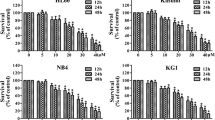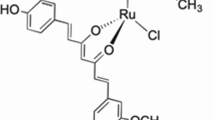Abstract
Purpose
Leukemias are groups of hematological malignancies with high incidence and mortality rates in patients worldwide. There have been shown in many studies that Wilms’ tumor1 (WT1) gene were highly expressed in leukemic blast cells. Curcuminoids, major active components of the spice turmeric, are well known for its anticancer. Curcuminoids consist of pure curcumin, demethoxycurcumin, and bisdemethoxycurcumin. In this study, the effect of each curcuminoids’components on WT1 gene expression in leukemic cell lines (K562, HL60, U937, and Molt4) was investigated.
Methods
The levels of WT1 mRNA and WT1 protein in leukemic cell lines were assessed by RT-PCR and Western blot analysis, respectively.
Results
It was found that the WT1 mRNAs were detected in all 4 types of leukemic cell lines. However, the WT1 protein levels were found only in the cell lines K562 and Molt4. Pure curcumin exhibited a strong inhibitory effect on WT1 mRNA and WT1 protein expression. The treatment of leukemic cell lines with non-cytotoxic doses (5, 10, and 15 μM) of pure curcumin for 2 days reduced the level of WT1 mRNA expression and WT1 protein in a dose-dependent manner. In addition, pure curcumin at 10 μM significantly decreased the level of WT1 mRNA and protein in a time-dependent manner.
Conclusion
Pure curcumin, an excellent curcuminoid derivative, decreased WT1 gene expression in both transcriptional and translational levels. Thus, pure curcumin is one of a potential chemotherapeutic agent used for treatment of human leukemia. However, its chemotherapeutic property will need to be studied more in future.








Similar content being viewed by others
References
Jemal A, Siegel R, Ward E, Murray T, Xu J, Smigal C, Thun MJ (2006) Cancer statistics CA. Cancer J Clin 56:106–130
Call KM, Glaser T, Ito CY, Buckler AJ, Pelletier J, Haber DA, Rose EA, Kral A, Yeger H, Lewis WH, Jones C, Housman DE (1990) Isolation and characterization of a zinc finger polypeptide gene at the human chromosome 11 Wilms’ tumor locus. Cell 60:509–520
Gessler M, Konig A, Bruns GA (1992) The genomic organization and expression of the WT1 gene. Genomics 12:807–813
Buckler AJ, Pelletier J, Haber DA, Glaser T, Housman DE (1991) Isolation, characterization, and expression of the murine Wilms’ tumor gene (WT1) during kidney development. Mol Cell Biol 11:1707–1712
Rauscher FJ III (1993) The WT1 Wilms tumor gene product: a developmentally regulated transcription factor in the kidney that functions as a tumor suppressor. FASEB J 7:896–903
Lewis WH, Yeger H, Bonetta L, Chan HS, Kang J, Junien C, Cowell J, Jones C, Dafoe LA (1988) Homozygous deletion of a DNA marker form chromosome 11p13 in sporadic Wilms’ tumor. Genomics 3:25–31
Kikuchi H, Akasaka Y, Nagai T, Umezawa A, Iri H, Kato S, Hata J (1992) Genomic changes in the WT gene (WT1) in Wilms’ tumors and their correlation with histology. Am J Pathol 140:781–786
Miyoshi Y, Ando A, Egawa C, Taguchi T, Tamaki Y, Tamaki H, Sugiyama H, Noguchi S (2002) High expression of Wilms’ tumor suppressor gene predicts poor prognosis in breast cancer patients. Clin Cancer Res 8:1167–1171
Sugiyama H (2001) Wilms’ tumor gene WT1: its oncogenic function and clinical application. Int J Hematol 73:177–187
Inoue K, Sugiyama H, Ogawa H, Nakagawa M, Yamagami T, Miwa H, Kita K, Hiraoka A, Masaoka T, Nasu K, Kyo T, Dohy H, Nakauchi H, Ishidate T, Akiyama T, Kishimoto T (1994) WT1 as a new prognostic factor and a new marker for the detection of minimal residual disease in acute leukemia. Blood 84:3071–3079
Bergmann L, Miething C, Maurer U, Brieger J, Karakas T, Weidmann E, Hoelzer D (1997) High levels of Wilms’ tumor gene (wt1) mRNA in acute myeloid leukemias are associated with a worse long-term outcome. Blood 90:1217–1225
Wang ZY, Qiu QQ, Enger KT, Deuel TF (1993) A second transcriptionally active DNA-binding site for the Wilms tumor gene product, WT1. Proc Natl Acad Sci USA 90:8896–8900
Rauscher FJ III, Morris JF, Tournay OE, Cook DM, Curran T (1990) Binding of the Wilms’ tumor locus zinc finger protein to the EGR-1 consensus sequence. Science 250:1259–1262
Menke AL, van der Eb AJ, Jochemsen AG (1998) The Wilms’ tumor 1 gene: oncogene or tumor suppressor gene? Int Rev Cytol 181:151–212
Menssen HD, Renkl HJ, Rodeck U, Maurer J, Notter M, Schwartz S, Reinhardt R, Thiel E (1995) Presence of Wilms’ tumor gene (WT1) transcripts and the WT1 nuclear protein in the majority of human acute leukemias. Leukemia 9:1060–1067
Guo X, Xu S, Dong Z (1999) WT1 gene expression in leukemia patients and its correlation with prognosis and multidrug resistance. Zhonghua Xue Ye Xue Za Zhi 20:69–72
Kelloff GJ, Crowell JA, Steele VE, Lubet RA, Malone WA, Boone CW, Kopelovich L, Hawk ET, Lieberman R, Lawrence JA, Ali I, Viner JL, Sigman CC (2000) Progress in cancer chemoprevention: development of diet-derived chemopreventive agents. J Nutr 130:467S-471S
Duvoix A, Blasius R, Delhalle S, Schnekenburger M, Morceau F, Henry E, Dicato M, Diederich M (2005) Chemopreventive and therapeutic effects of curcumin. Cancer Lett 223:181–190
Nagabhushan M, Bhide SV (1992) Curcumin as an inhibitor of cancer. J Am Coll Nutr 11: 192–198
Huang MT, Wang ZY, Georgiadis CA, Laskin JD, Conney AH (1992) Inhibitory effects of curcumin on tumor initiation by benzo(a)pyrene and 7,12 dimethylbenz (a) antracene. Carcinogenesis 13:2183–2186
Azuine MA, Bhide SV (1992) Chemopreventive effect of turmeric against stomach and skin tumors induced by chemical carcinogens in Swiss mice. Nutr Cancer 17:77–83
Duvoix A, Morceau F, Schnekenburger M, Delhalle S, Galteau MM, Dicato M, Diederich M (2003) Curcumin induced cell death in two leukemia cell lines: K562 and Jurkat. Ann NY Acad Sci 1010:389–392
Kuo ML, Huang TS, Lin JK (1996) Curcumin, an antioxidant and anti-tumor promoter, induces apoptosis in human leukemia cells. Biochim Biophys Acta 1317:95–100
Anuchapreeda S, Sadjapong W, Duangrat C, Limtrakul P (2006) The cytotoxic effect of curcumin, demethoxycurcumin and bisdemethoxycurcumin purified form turmeric powder on luekemic cell lines. Bull Chiang Mai Assoc Med Sci 39:60–71
Anuchapreeda S, Limtrakul P, Thanarattanakorn R, Sittipreechacharn S, Chanarat P (2006) Inhibitory effect of curcumin on WT1 gene expression in patient leukemic cells. Arch Pharm Res 29:80–87
Anuchapreeda S, Thanarattanakorn R, Sittipreechacharn S, Chanarat P, Limtrakul P (2006) Curcumin inhibits WT1 gene expression in human leukemic K562 cells. Acta Pharmacol Sin 27:360–366
Limtrakul P, Anuchapreeda S, Buddhasukh D (2004) Modulation of human multidrug-resistance MDR-1 gene by natural curcuminoids. BMC Cancer 4:1–6
Chearwae W, Anuchapreeda S, Nandigama K, Ambudkar SV, Limtrakul P (2004) Biochemical mechanism of modulation of human P-glycoprotein (ABCB1) by curcumin I, II, and III purified from Turmeric powder. Biochem Pharmacol 68:2043–2052
Oji Y, Ogawa H, Tamaki H, Oka Y, Tsuboi A, Kim EH, Soma T, Tatekawa T, Kawakami M, Asada M, Kishimoto T, Sugiyama H (1999) Expression of the Wilms’ tumor gene WT1 in solid tumors and its involvement in tumor cell growth. Jpn J Cancer Res 90:194–204
Inoue K, Ogawa H, Yamagami T, Soma T, Tani Y, Tatekawa T, Oji Y, Tamaki H, Kyo T, Dohy H, Hiraoka A, Masaoka T, Kishimoto T, Sugiyama H (1996) Long-term follow-up of minimal residual disease in leukemia patients by monitoring WT1 (Wilms tumor gene) expression levels. Blood 88:2267–2278
Inoue K, Ogawa H, Sonoda Y, Kimura T, Sakabe H, Oka Y, Miyake S, Tamaki H, Oji Y, Yamagami T, Tatekawa T, Soma T, Kishimoto T, Sugiyama H (1997) Aberrant overexpression of the Wilms tumor gene (WT1) in human leukemia. Blood 89:1405–1412
Tamaki H, Ogawa H, Inoue K, Soma T, Yamagami T, Miyake S, Oka Y, Oji Y, Tatekawa T, Tsuboi A, Tagawa S, Kitani T, Aozasa K, Kishimoto T, Sugiyama H, Miwa H, Kita K (1996) Increased expression of the Wilms tumor gene (WT1) at relapse in acute leukemia. Blood 88:4396–4398
Wu Y, Fraizer GC, Saunders GF (1995) GATA-1 transactivates the WT1 hematopoietic specific enhancer. J Biol Chem 270:5944–5949
Lantz RC, Chen GJ, Solyom AM, Jolad SD, Timmermann BN (2005) The effect of turmeric extracts on inflammatory mediator production. Phytomedicine 12:445–452
Chen WH, Chen Y, Gu JX, He J (2004) Effect of curcumin on STAT5 signaling molecule in K562 cells. Chin J Hematol 25:151–153
Huang TS, Lee SC, Lin JK (1991) Suppression of c-Jun/AP-1 activation by an inhibitor of tumor promotion in mouse fibroblast cells. Proc Natl Acad Sci USA 88: 5292–5296
Pan MH, Lin-Shiaut SY, Lin JK (2000) Comparative studies on the suppression of nitric oxide synthase by curcumin and its hydrogenated metabolites through down-regulation of IkB kinase and NFkB activation in macrophage. Biochem Pharmacol 60:1665–1676
Inoue K, Tamaki H, Ogawa H, Oka Y, Soma T, Tatekawa T, Oji Y, Tsuboi A, Kim EH, Kawakami M, Akiyama T, Kishimoto T, Sugiyama H (1998) Wilms’ tumor gene (WT1) competes with differentiation-inducing signal in hematopoietic progenitor cells. Blood 91:2969–2976
Lee E, Surh YJ (1998) Induction of apoptosis in HL60 cells by pungent vanilloids, [6]-gingerol and [6]-paradol. Cancer Lett 134:163–138
Simon A, Allais DP, Duroux JL, Basly JP, Durand-Fontanier S, Delage C (1998) Inhibitory effect of curcuminoids on MCF-7 cell proliferation and structure-activity relationships. Cancer Lett 129:111–116
Kunchandy E, Rao MNA (1990) Oxygen radical scavenging activity of curumin. Int J Pharm 58:237–240
Soudamini KK, Kuttan R (1989) Inhibition of chemical carcinogenesis by curcumin. J Ethnopharmacol 27:227–233
Toda S, Miyase T, Arichi H, Tanizawa H, Takino Y (1985) Natural antioxidants. III. Antioxidative components isolated from rhizome of Curcuma longa L. Chem Pharm Bull 33:1725–1728
Ramsewak RS, DeWitt DL, Nair MG (2000) Cytotoxicity, antioxidant and anti-inflammatory activities of curcumins I-III from Curcuma longa. Phytomedicine 7:303–308
Ahsan H, Parveen N, Khan NU, Hadi SM (1999) Pro-oxidant, anti-oxidant and cleavage activities on DNA of curcumin and its derivatives demethoxycurcumin and bisdemethoxycurcumin. Chem Biol Interact 121:161–175
Acknowledgments
This work was supported by grants from the National Research Council of Thailand, Chiang Mai University Research Fund, the National Science and Technology Development Agency (NSTDA) of Thailand, Biomedical Technology Research Center, and Faculty of Associated Medical Sciences Endowment Fund. We gratefully acknowledge Dr. Dale E. Taneyhill, Mr. Greg Sholly for their critical reading of the manuscript.
Author information
Authors and Affiliations
Corresponding author
Rights and permissions
About this article
Cite this article
Anuchapreeda, S., Tima, S., Duangrat, C. et al. Effect of pure curcumin, demethoxycurcumin, and bisdemethoxycurcumin on WT1 gene expression in leukemic cell lines. Cancer Chemother Pharmacol 62, 585–594 (2008). https://doi.org/10.1007/s00280-007-0642-1
Received:
Accepted:
Published:
Issue Date:
DOI: https://doi.org/10.1007/s00280-007-0642-1




